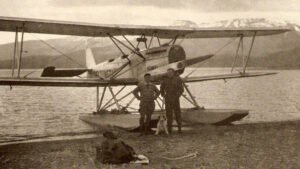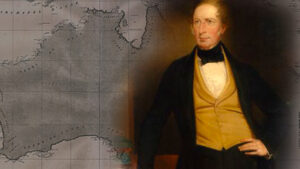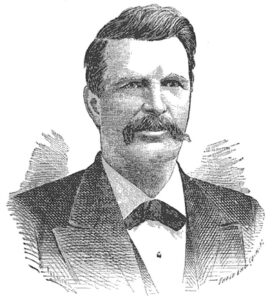Anyone who heads into the field needs something to record notes, whether it’s a pen and notebook or an iPad. Modern electronic technology has many advantages, but built-in obsolescence and reliance on power sources are definite liabilities.
In contrast, typewriters have served reliably in the field for 150 years. While they aren’t perfect, I’d bet the typewriter’s overall record stacks up well against any contemporary device. Typewriters have been along on any number of historic expeditions.
Although he’s not usually included in the canon of great explorers, Mark Twain was certainly an adventurer, albeit one given to exaggeration. In Roughing It, he reported “toiling laboriously up a mountain about a thousand miles high” in the Sierra Nevada.

A Sholes & Glidden typewriter, similar to the one Mark Twain used to compose ‘Life on the Mississippi.’ Photo: Wisconsinhistory.org
During that 1861 trip, he made his notes with pen and paper. But in the early 1870s, Twain acquired a Sholes & Glidden typewriter, sold by Remington Arms. Its weight and bulk made it impractical to carry easily, but Twain used it at home and, apparently, when traveling by train. Appearing in 1883, Life on the Mississippi was the first published book ever to be composed on a typewriter.

Roald Amundsen not only used a Corona typewriter, he endorsed it for the manufacturer. Here, he is still planning to go to the North Pole. When he learned of Peary’s claim to have reached the North Pole, Amundsen abruptly turned his attention south.
Typewriters in polar exploration
A more fully certified explorer, Roald Amundsen, was an early adopter of typewriters and preferred the Corona 3. An early portable, it weighed about 2.7kg. Introduced in 1912, it was extremely popular with journalists, World War I correspondents, and explorers.

Shackleton’s men used a Yost typewriter aboard the ‘Endurance.’ Photo: Oztypewriter
Shackleton also brought one on his 1914-17 expedition. Members of his relief party used a Corona for two years on Ross Island. The Yost, a larger, ”desktop” model, served on the Endurance.
“The fact that the machine is in perfect writing order after two years use under strenuous conditions proves that it is a ‘high grade’ typewriter in portable form,” enthused Shackleton.

Shackleton’s relief party used a trusty Corona 3 for two years on Ross Island. Photo: Museums Victoria
Still in the Southern Hemisphere, Apsley Cherry-Garrard, who accompanied Scott’s Terra Nova expedition in 1910-12, most likely used an Underwood Standard #5. We aren’t sure whether he later wrote his classic, The Worst Journey in the World, on the same model.

Apsley Cherry-Garrard at work in Antarctica on what is likely an Underwood Standard #5. Cherry-Garrard’s vision was extremely poor and he probably removed his glasses for the portrait. Photo: PA1-f-067-040-4. Alexander Turnbull Library, Wellington, New Zealand
The sun also rises on Underwoods
At first, writer/adventurer Ernest Hemingway also used a Corona 3. It was his first typewriter and a gift from his fiancée. He wrote extensively with it in Paris and Spain.
Known for being as hard on his typewriters as he was on his women, Hemingway also used a 1926 Underwood Standard Portable, an Underwood Noiseless Portable, several Royal portables, and possibly a Swedish Halda P over his career.
Not known for his poetry, Papa nonetheless wrote a poem in 1922 about his Corona:
The mills of the gods grind slowly
But this mill
Chatters in mechanical staccato,
Ugly short infantry of the mind,
Advancing over difficult terrain,
Make this Corona
Their mitrailleuse.
The mitrailleuse was one of the earliest machine guns.
Speaking of guns, Osa Johnson, along with her husband Martin, explored and made films in the South Seas and Africa. She once saved her husband’s life by calmly shooting a charging rhino.

Osa Johnson. Photo: The Martin and Osa Johnson Safari Museum
Osa typed extensive field notes and wrote a 1940 bestseller describing her life with Martin. Below, she uses a very rare “Gibbon” typewriter.

Osa Johnson at work, with friends. Photo: The Martin and Osa Johnson Safari Museum
Call of the wild
As it happens, Martin Johnson was good friends with Jack London, who used a 1902 Bar Lock #10. London once wrote, “If typewriters hadn’t been invented by the time I began to write, I doubt if the world would ever have heard of Jack London. No one would have had the patience to read more than a page of my longhand!”

Jack London’s Bar Lock #10 typewriter. Photo: American Writers Museum
A relatively unknown but interesting explorer is Phyllis Wager. Because she was female, Britain’s Foreign Office had to give special permission for her to accompany her husband, a geologist. Their 1935 expedition was based in Kangerlussuaq Fiord, East Greenland.
Her daughter, Jane Hargreaves, wrote in The Guardian that Wager “cooked for the expedition members and recorded the weather three times daily. She learned to prepare and cure seal skins and to sew sealskin clothes with traditional bead decorations, and, gradually learning some of the Eskimo language, entertained the Inuit people, who loved to dance to the wind-up gramophone.”

Phyllis Wager’s Remington Home Portable. Photo: University of Cambridge
Wager had taken a Remington Home Portable typewriter to Greenland and typed daily notes about her life and the expedition’s progress. She likely also typed her husband’s official reports and later used it to write her own book of reminiscences. Her Remington model hit the market in 1928 and proved popular with the public.

Thor Heyerdahl at work on a Hermes Featherweight aboard the Kon-Tiki in 1947. Photo: Oztypewriter
On board the Kon-Tiki
Thor Heyerdahl carried a Hermes Featherweight on the Kon-Tiki, but he supposedly wrote his book about the expedition on an Olivetti Studio 42.
The amazing Sir Hubert Wilkins was devoted to Underwoods, as was Farley Mowat. The list goes on and on. Howard Carter, the famous Egyptologist who discovered King Tut’s tomb, used a Royal Model P in the field. Jean-Baptist Charcot, leader of the French Antarctic Expedition, used a Remington. Edward Abbey preferred a Royal KMG. Margaret Atwood used an IBM Selectric for many years, but now, like everyone else, she uses a laptop.

Margaret Atwood at work while traveling. Photo: Danny Catt
If Shackleton’s comments about his Corona’s durability after two years on Ross Island isn’t proof of the value of typewriters in the field, here’s another impressive tale about a Corona 3. It was reported by typewriter collector and journalist Robert Messenger, in his Oztypewriter blog, on July 18, 2014.
In May 1919, George Ely Russell set off “from Seattle in an 18-foot long, canvas-covered Peterborough canoe to paddle 1,000 miles to Juneau, Alaska. Russell took with him a Corona 3 folding portable typewriter [which] he had used on the battlefronts of France in World War I. About one-third of the way into his epic voyage…Russell dropped his typewriter into seven feet of water.
“Unable to fetch the Corona 3 off the bay floor with a salmon hook, Russell stripped off, dived in, and rescued the portable from a salty grave. He wiped it off with an old rag, dried it in front of his night fire…and went on to write one-quarter of a million words with it! These were incorporated into his book called Eighty Days in the Wilderness: Seattle to Alaska by Canoe.”
Reliable but not perfect
Despite their many advantages, typewriters, like our infernal electronics, are not immune to malfunctions. Peter Weil, anthropologist and typewriter collector/historian, wrote to me about documenting his research in Gambia and Senegal in the late 1960s. His Olivetti 22 (not to be confused with the legendary Olivetti Lettera 32) frequently gave him problems. The ribbon vibrator stopped working and the carriage jammed. Weil’s wife, as frustrated by these problems as he was, tossed the typewriter overboard on their return home.
On a happier note, an Olympia Traveler accompanied Weil to Africa in the 1980s. It served him admirably through many reports, complete with charts and tables…”a great field typewriter…[that] never failed.”
All well and good, you may be thinking; it’s nice to read about these old machines. It’s even better when you realize that every machine mentioned (except for Osa Johnson’s “Gibbon typewriter”) can be found today in good working order, even the venerable Corona 3. The first draft of this article was produced on a Groma Modell N.






